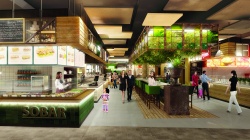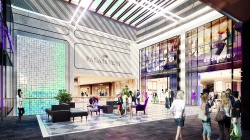
The big success of eCommerce is not just a problem for small retailers in city centers – shopping mall operators also need to face competition by online retail and create new incentives for customers to continue frequenting their stores.
According to Dirk Hünerbein, project partner at the Drees & Sommer consulting firm, eCommerce is said to achieve a 30 percent share of the overall German retail sector by 2020. For brick-and-mortar retailers, this doesn’t just translate into decreasing sales; instead, this also opens up various ways to save for retailers that consequently emphasize multichannel concepts thanks to a decreasing need for floor space.
“While electronics retailers, for instance, needed large floor spaces until recently, those can now be increasingly reduced – room for CDs and DVDs is no longer being allocated since those are increasingly being purchased online,“ says Hünerbein. ”It is mandatory for new construction to direct the structural conditions towards continuous changes in floor space requirements. This subject was severely neglected for a long time with already existing buildings. This comes back to haunt proprietors today if the renters’ needs change. The structural changes are very expensive while floor spaces would remain empty during the renovation – a no-go for a shopping mall.“

Until a while ago, demographers were certain that city centers will continue to lose population and more people would move to the suburbs. Yet the opposite is true and there is currently a process of “re-urbanization”. Of course, this presents a problem for shopping centers out in the suburbs while it provides a chance for inner-city retailers and shopping malls at the same time. After all, an eCommerce share of 30 percent means that 70 percent of retail in Germany is still going to take place in brick—and-mortar stores in 2020. And this typically means in city centers.
Industry report with a special focus on customers
In early July of 2015, mall operator ECE introduced its first market report. It has the indicative title “Focus on the customer“ and documents the changes and challenges in the shopping mall industry. To find out what customers really expect from shopping malls today, ECE and Forsa conducted a representative survey on opinions and attitudes on shopping centers within the scope of the report in May 2015. The result: 62 percent of Germans still prefer retailers in the city, whereas shopping malls ranked second with 21 percent – still just ahead of online retail at 19 percent.

Customers want to buy, shop and linger
The results of the survey also highlight the different functions shopping malls need and should fulfill today in the eyes of customers. Strictly speaking, they need to make three things possible: shopping, provide local amenities, and gastronomy. This way, they definitely reach the customer, since the majority of ECE respondents (70 percent) specifically visits a shopping mall either to shop, to run everyday errands or to eat. The chance to stroll in a relaxed atmosphere through the center is important for 61 percent of respondents while a whopping 85 percent could see themselves taking advantage of the gastronomic options.
Gastronomy in the mall is becoming more and more important
It therefore still remains important for shopping mall visitors to run their errands here and satisfy their consumer needs. At the same time, however, other aspects such as a great shopping experience and emotional factors such as a pleasant ambiance are becoming increasingly important.
“Visitors expect more service, a great experience, and gastronomic options. They want their needs to be met in a personalized manner and prefer a variety of ever-changing entertainment options. However, the best innovation is useless when core areas such as layout, parking decks, restrooms or the general quality of experience do not satisfy the customer,“ believes Alexander Otto, CEO of ECE.
Every shopping center needs personalized choices

A personalized selection at every location is a very important subject, particularly in times of increasingly successful online retail, and it is also crucial to the success of a mall. ”At our Palais Vest shopping center in Recklinghausen, for example, we tried to attract the type of retailers that were previously not represented in the city and the region. That means, there is no cannibalization effect in this case but rather an additive effect instead. We subsequently have 76 retailers in this center whose stores were previously not represented in the city,“ explains Ulrich Wölfer of mall operator mfi AG.
”As an operator today, you need to address a site on a very individual basis and you must not neglect general conditions such as the customer base and the competitive environment. Today, an operator must not make the mistake of placing a shopping center as an isolated element in a town center, but should emphasize strong integration,” Wölfer sums up the current challenges.
Shopping centers need to be “individual all-rounders”
This much is clear: today shopping centers still need to offer stores and products for local amenities and shopping; yet customers also generally highly emphasize a high-quality experience with sufficient options to linger and rest, a clear layout and a pleasant ambiance. As an integral part of the shopping experience, the gastronomic selection becomes increasingly important and plays a part in the propensity to linger in a shopping mall.
Author: Daniel Stöter, iXtenso.com









